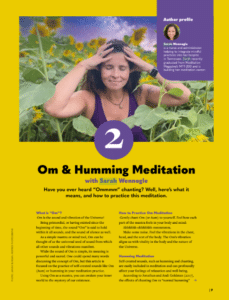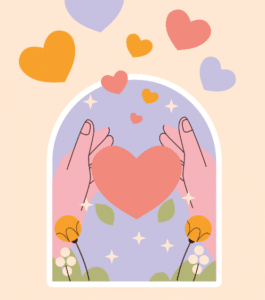WARNING: TONGLEN IS AN ADVANCED MEDITATION THAT SHOULD ONLY BE PRACTICED BY THOSE WHO ALREADY HAVE AN ESTABLISHED MEDITATION PRACTICE.
Tonglen is an ancient Tibetan meditation, meant to cultivate a kind & loving heart.
The Tibetan word “tong” means “sending” and “len” means “receiving.” “Tonglen,” or “sending and receiving,” refers to the sending of comfort & happiness to others, while receiving their pain & suffering in return.
Yes, you read that right: we are giving away our own comfort and happiness, in exchange for other peoples’ pain and suffering.
Why in the world would anybody want to do this? Well, in this very counterintuitive idea lies the beauty and genius of Tonglen.
As meditators, we are able to handle pain and suffering in a way that most people can’t. When we experience pain, we greet it with mindfulness & equanimity (non-judgmental awareness), in the pure, vast “blue sky” of consciousness. We welcome all experiences that arise – the painful, the pleasurable, and everything in between. Through this non-judgmental awareness, we transmute pain into peace, and suffering into serenity.
By “receiving” the pain and suffering of others, we are feeling the pain so that others don’t have to. We then use our power of equanimity to transmute the pain into peace, which we then send out in its place.
This radical and profound method is able to transform our suffering, and the suffering of others, into fertilizer for love, compassion, courage, and wisdom.
The basic premise of tonglen is to visualize yourself breathing in suffering and breathing out relief. Each breath trains your mind to stop its habitual pattern of seeking pleasure and avoiding pain, and instead allows you to expand your window of tolerance for what you would normally consider “unwelcome.” By gently receiving suffering on every inhale and sending out relief on each exhale your mind becomes more resilient, courageous, and loving.
With practice, tonglen will help you increase your ability to welcome the unwelcome, while also deeply connecting you to the shared suffering we all experience. It will show you how to take what you normally want to run away from, and transform it into your path of awakening.
Four Steps of Tonglen
- Step 1: Be the Blue Sky. Sit down for a moment, before you start the tonglen visualizations, and rest in a state of open awareness. Reconnect with the vastness and clarity of the mind – the pure, spacious consciousness in which all of your thoughts and emotions arise – that is often forgotten about in the messiness of daily life. This spacious and loving awareness is your true nature. It is vast enough to hold all the 10,000 joys and sorrows of your life. When you begin the tonglen practice by resting in this “Big Mind,” it gives you the courage and strength to actually welcome the suffering that you are about to transmute.
- Step 2: Be the Air Purifier. This is the first visualization exercise in tonglen meditation. Imagine that the air around you is filled with thick, heavy, black smoke (representing the suffering in the world around you). On each inhale, breathe in this heavy darkness through every pore in your body. Gather it into the center of your chest, feeling it fully, and allowing your heart to transform it into light, clear, clean energy. On each exhale, breathe out this bright, white, light energy, allowing it to radiate from every pore of your body. Through this exercise, you are basically acting as a spiritual “air purifier,” cleaning the energy of the world around you.
- Step 3: Transmute the suffering of one person. After you have taken a few breaths with the black smoke visualization, think of a specific painful situation that you or a loved one are currently struggling with. Begin breathing in the suffering of that situation. Let it touch your heart. Then breathe out relief. For example, if you are struggling with an illness, breathe in all the symptoms and pain associated with the illness, and breathe out health and ease. On the inhales feel the suffering, on the exhales breathe out comfort & relief.
- Step 4: Transmute the suffering of the world. After a few minutes of working with this specific situation, expand your practice to include all others experiencing the same suffering. Breathe in the suffering of all beings feeling just like you (or your loved one). Free them from the suffering with each inhale, and send out its opposite on each exhale. Continue doing this for a few more minutes, and then rest one last time in open “Blue Sky” awareness before you end the meditation.
Try taking tonglen off the cushion! Aside from being a powerful formal meditation, tonglen can also be a transformative on-the-spot practice. Any time you see suffering as you go through your day, breathe it in and send out relief. It can be done for a moment of anxiety, a homeless person you see on the street, or even a politician who makes you enraged. Anything unpleasant or uncomfortable that you normally would want to run away from can be a place of practice. If you do this every time you experience pain or suffering, something powerful happens: each difficult emotion, person, or situation you meet becomes the training ground for love.

To get this issue (and also get 4 more issues in your first year), don’t forget to subscribe! Digital mag | print magazine!















In order to be successful in the video game geometry dash meltdown you will need to pay close attention to the rhythm. The objective of the game is to guide a cube safely past an overwhelming number of challenges. In the cube world, you will encounter obstacles that are so severe that you will find it difficult to catch your breath after completing them.